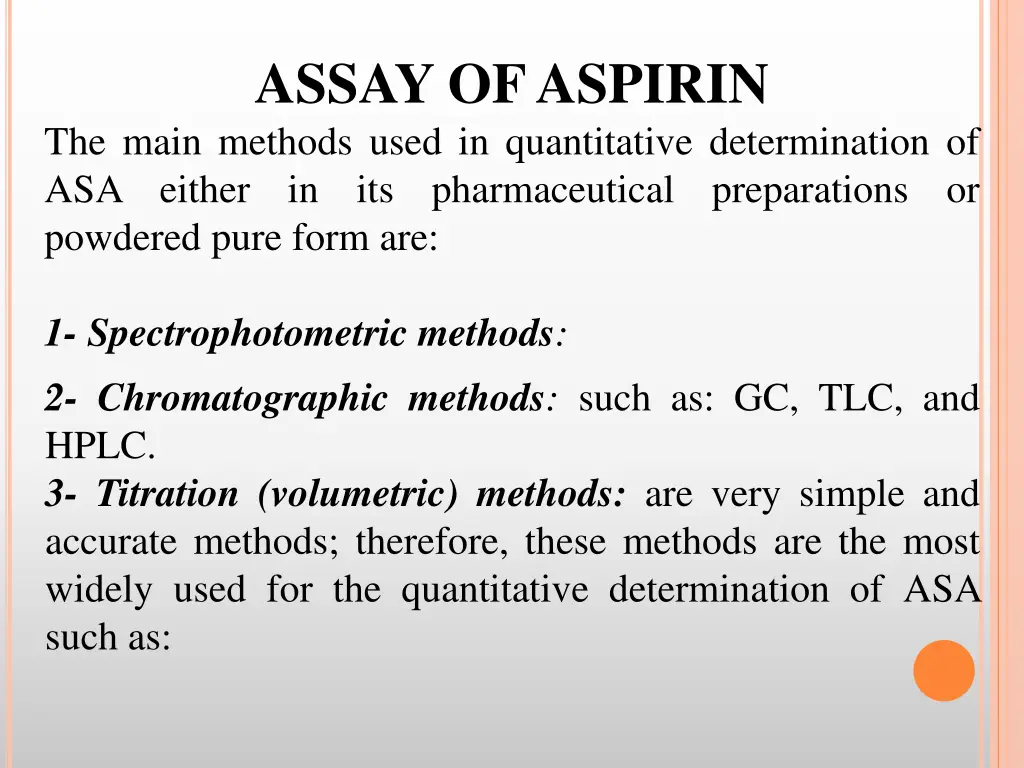
Quantitative Determination of Aspirin Methods
Learn about the various methods used for the quantitative determination of aspirin, including spectrophotometric, chromatographic, and titration methods. Discover how direct and back titration methods are applied, along with the principles and requirements of titration assays. Explore the process of determining aspirin content through titration assays and the importance of conducting blank solutions for accuracy.
Download Presentation

Please find below an Image/Link to download the presentation.
The content on the website is provided AS IS for your information and personal use only. It may not be sold, licensed, or shared on other websites without obtaining consent from the author. If you encounter any issues during the download, it is possible that the publisher has removed the file from their server.
You are allowed to download the files provided on this website for personal or commercial use, subject to the condition that they are used lawfully. All files are the property of their respective owners.
The content on the website is provided AS IS for your information and personal use only. It may not be sold, licensed, or shared on other websites without obtaining consent from the author.
E N D
Presentation Transcript
ASSAY OF ASPIRIN The main methods used in quantitative determination of ASA either in its pharmaceutical preparations or powdered pure form are: 1- Spectrophotometric methods: .2- Chromatographic methods: such as: GC, TLC, and HPLC. 3- Titration (volumetric) methods:are very simple and accurate methods; therefore, these methods are the most widely used for the quantitative determination of ASA such as:
A- Direct titration method: ASA can be determined after dissolving it in ethanol by using a standard base as NaOH as a titrant solution and phenolphthalein (phph) as an indicator. B- Back titration method: is one of volumetric methods which includes the addition of an excess of standard volumetric sol. to a weight amount of a sample and then determination for the excess unreacted (no required or utilized by the sample), then the amount of volumetric sol. used by the substance is determined.
This method is used for: 1- Volatile substances like NH3. 2- Insoluble substances, e.g. CaCO3. 3- Substances which decompose on heating, e.g. formaldehyde. 4- Substances for which quantitative reaction proceeds rapidly only in the presence of excess amount of reagent, e.g. lactic acid & aspirin.
Requirements of titration assay reactions: 1- The reaction should be complete and irreversible. 2- Rapid. 3- Endpoint can be easily detected. 4- Can be represented by a chemical equation (to calculate the chemical factor). Principle of assay: ASA is readily dissolved in ethanol and 0.5 N NaOH solution was then added, the hydrolysis of ASA takes place when the stoppered solution allowed to stand for 30 min. the excess NaOH volume is titrated with 0.5 N HCl solution using phph as indicator, the same titration procedure was repeated except that ASA was omitted from the solution to serve as a blank.
The difference between the vol. of HCl used in both titrations represents the required amount of NaOH solution to hydrolyze the ester gp in ASA beside the conversion of the COOH gp to sod. carboxylate. The hydrolysis solution must be protected from air because CO2 causes a color change of the indicator before the endpoint is reached [some NaOH Na2CO3 Vex. NaOH].
Also it is necessary to carry blank solution under the same condition without ASA in order to reduce any error due to the presence of impurities or to the condition. Phph (phenol sulfonphthaleine) indicator is colorless in acidic media and it changes to pink in basic solution. pH range is 6.4-8.
Procedure: 1. 0.5 N HCl was prepared and standardized with Na2CO3 using methyl orange as indicator. 2. 0.5 N NaOH was prepared and standardized with 0.5 N HCl using phph as indicator. 3. Dissolve ASA sample in 5 ml ethanol 95 % and then add 25 ml of 0.5 N NaOH, the container of the mixture was stoppered and allowed to stand for hour to complete the hydrolysis of ASA. 4. 1-2 drops of bromophenol blue (bpb) indicator was added and the solution was titrated with 0.5 N HCl. The endpoint is pink colorless. 5. Repeat the same procedure without ASA.
Note: Back titration of the excess alkali is necessary to carry out a blank experiment without acetyl salicylic acid. Heating and cooling of alkaline liquid results in an apparent changes in the strength of certain indicators used. This may be due to the absorption of atmospheric CO2 gas. The CO2 is rapidly absorbed by the hot sol (NaOH) to form sod. carbonate. In the back titration , CO2 causes a color change of indicator before the actual endpoint.
Calculations: V1 of blank V2 of unk. = V3 of NaOH [VHCl VNaOH], [VHCl VNaOH free], [VNaOH VASA] V3 x 0.04504 g ASA = 1 mole ASA 2 mole NaOH 180.15 g/ml ASA 2000 ml 1 N NaOH 90.075 g/ml ASA 1000 ml 1 N NaOH 90.075/2 g/ml ASA 1000 ml N NaOH 45.04 g/ml ASA 1000 ml 0.5 N NaOH 45.04/1000 g/ml C9H8O4 1 ml 0.5 N NaOH 0.04504 g/ml C9H8O4 1 ml 0.5 N NaOH g ASA in our sample






















